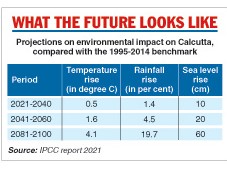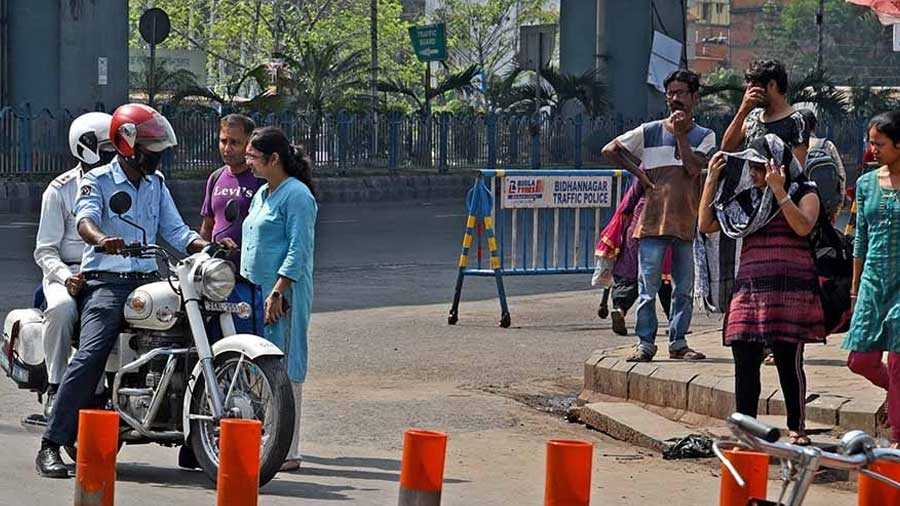The city has recorded the maximum rise in warming over the past seven decades among the urban centres across the globe covered in a recent report of the Intergovernmental Panel on Climate Change (IPCC), a United Nations platform.
The report contains a map, under the section “Regional Factsheet — Urban Areas”, which shows that the Kolkata area from 1950 to 2018 has recorded the highest rise in the surface air temperature — 2.6 degrees Celsius — among the cities and regions studied.
Tehran comes second with a 2.3 degree rise in the surface air temperature, followed by Moscow, which recorded a 1 degree rise.
The study covered 20 cities and regions, including New York City, Mexico City, Buenos Aires, Johannesburg, Moscow, Cairo and cities in China, Japan and Thailand.

The map also shows that urbanisation accounts for more than 80 per cent of the temperature rise in Kolkata — proportionately the highest among all the cities and regions in the study. The rest of the rise is contributed by activities in surrounding areas.
“Urbanisation has exacerbated the effects of global warming in cities (very high confidence),” the report says.
The IPCC report (IPCC AR 6 WG1) explains that “urban heat island effect results from… reduced ventilation and heat trapping due to close proximity of tall buildings, heat generated directly from human activities, the heat-absorbing properties of concrete and other urban building materials, and the limited amount of vegetation”.
Aniruddha Mukherjee, a professor of environment science in Calcutta University, said Kolkata had all the attributes mentioned in the report in the context of urbanisation and hence, was an ideal candidate for temperature rise.
An urban development expert from IIT Kharagpur echoed Mukherjee, saying: “It’s no surprise that the city has experienced record temperature rise, as cited by the IPCC report.”
Kolkata, he said, has witnessed rapid, unplanned urbanisation over the past few decades, as evident in the mushrooming of multi-storeyed buildings that came up after felling trees or on plots that were once water bodies.
An interactive atlas in the report predicts an even scarier future unless the city reduces its emissions significantly and quickly.
According to the atlas, the annual mean temperature of the city may rise by around 4.5 degrees Celsius during 2081-2100, compared with the pre-industrial period, if the greenhouse gas emission grows unchecked.
The rise may be 4 degrees if 1995-2014 is considered as the benchmark, an indicator to the rapid rise in temperature in recent times.
Normally, the pre-industrial period — 1850-1900 — is considered a benchmark as human-induced emission started to accumulate in the atmosphere with the onset of industrialisation.
Even in the best possible emission scenario, Kolkata’s annual mean temperature may rise by 1.6 degrees during 2080-2100. And in the most likely scenario, the rise will be 2.4 degrees, compared with the projected 2-degree rise in the global temperature.
The rise in Kolkata’s temperature is likely to be in the range of 1.4 to 1.9 degrees during 2041-60.
By the end of the century, the city may experience 35 degree Celsius or more for 150 days in a year in the worst case scenario.
“With high confidence we can say that extreme heat and heat-wave phenomena are going to increase in Kolkata, as predicted by the interactive atlas,” said Subimal Ghosh, a scientist from IIT Mumbai and a lead author of the IPCC report.
Saiful Islam, a professor of the Bangladesh University of Engineering and Technology and another lead author of the report, said unless the emission level was curbed at the earliest, extremely severe or super-cyclones were likely to hit the Sunderbans area in increasing frequency, affecting cities like Kolkata and Khulna.
Islam also pointed out that the coastal areas and cites, including Kolkata, were expected to be impacted by compound events – several climate phenomena acting together – with intense cyclones, rise in the sea level and increased precipitation, especially at short bursts, striking together.
The interactive atlas also shows that the water level of the Bay of Bengal, adjoining the Sunderbans, is slated to rise by 60cm by the end of the century, compared with the 1995-2014 level, a sixfold increase compared with the 2021-2040 prediction.
The rise in the water level will increase the erosion and flooding in the Sunderbans and also magnify the flooding impact on Kolkata.
“Already, the Sunderbans area experiences the highest sea level rise in the country and almost double when compared with the global average,” said Sugata Hazra, a professor of oceanography in Jadavpur University.
“Kolkata, hardly 100km from the Sunderbans, will have to bear the brunt of the sea level rise. The high tide will be higher and there is a possibility of more severe and longer duration of floo-ding,” said Ghosh of IIT Mumbai.
“The situation will be particularly difficult for Kolkata as it has an old, highly silted drainage system that was installed during the British era,” said environmentalist and drainage expert Arunabha Majumdar.
